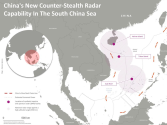The critical point here is that all of the ROCAF (Armed Forces not Air Force) planned tactics and capabilities were oriented around the assumption that the PLA could only conduct strikes from a standoff position and would have to actively exert itself for limited access over Taiwan’s airspace. It’s why the ROCAF brass insisted on protecting the budget for fighter procurement despite the political demand to shift purely to a missile based porcupine strategy. They knew if they lost control over their own airspace nothing else about the strategies they invested decades into would work.Density of traffic works both ways. You can’t rely on massive civilian traffic to hide your logistical tail and also have clear roads for jets to land on.
If you start blocked traffic to prepare the roads for aircraft to land, you are going to quickly create massive traffic jams that are easily detected even without enemy ISR assets in range, as you can see that from just civilian traffic apps.
There are a small number of roads which are long and straight enough for jet fighter operations. The PLA can probably keep all those stretches monitories 24/7 with drones alone. Add in some AI pattern recognition overlapping unexpected traffic jams with those stretches of roads and PLA strike sites and any prep work to get roads ready for fighters will stand out like flashing flares.
Sweden made it work because of its low population density and a road network designed with such a need in mind, and even then it’s more of a theoretical capacity that has never been tested in actual real world combat operations.
If Taiwan seriously desired such a capability, it should have made a proper attempt to buy Harrier jump jets. STOVL jets would have given the PLA an actual challenge. But I guess one can’t be too harsh on the ROCAF for being caught out by the sheer speed and scale of Chinese advancement in the last 20 years. They went from decisive battle at a distance (to Taiwan) to facing PLAAF air dominance over Taiwan within a generation. By the time they realised they needed harriers, almost all harriers were retired. The only other STOVL option is the F35B, which is off limits.
In a sense, that tells you all you need to know about how committed America is to shoring up Taiwan’s defences. If they truly wanted to make Taiwan a tough nut for China, offering F35Bs would have given Chinese planners a real headache.
All of the hype and noise by the US about Taiwan increasing defence spending isn’t really about maximising Taiwan’s military capabilities, but more about profit maximisation for the USA.
Quite literally any answer you could come up with to support high tempo activities to protect the island perimeter or prevent the PLA from landing effectively is DOA if Taiwan loses control of its air domain, especially given the density of mass the PLA can now flood into the zone. The inability to prevent the PLA from asserting total operational control over Taiwan’s air domain with a massive amount of surveillance and strike capacity means any ground force accumulation needed to make perimeter defense possible becomes sitting ducks. There is no reason for the PLA to put ground forces into heavily contested situations when they can clear out area with air power first, and if you cannot provide viable answers to stop that first none of the other tactical minutiae matters.
This hard reality is *also* why there is simply no situation where the PLA progresses to landing without first ripping Taiwan’s integrated air defense and counterstrike system to shreds, which is essentially the core objective of the first wave strike campaign. By the time the PLA is confident about asserting total air superiority over Taiwan the best any remaining anti air assets could do would be to take half blind potshots. And there’s no reasonable possibility of the PLA operating in a more contested scenario for either their opening wave strike campaign or assertion of total air control because the sheer mass disparity guarantees that without an effective intervention by the US they will get their ideal conditions for moving through their invasion sequence sooner or later. Any reasonably plausible scenario for mucking up this invasion sequence would first need to answer how the US can gather enough force on short turnaround in time to intervene. Without that there is no meaningful resistance that today’s ROCAF can field against today’s PLA.
Last edited:


